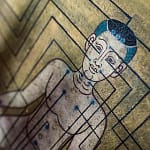Trimarma means three-marmas. Marmas are exposed weak sensitive or vulnerable parts of body as per Ayurveda which are vital for the constitution of a body. Trimarma got its origin after observation of patients by our Acharyas in warfare. In patients found hurt in the war, various injuries were observed, some of which were too fatal and warriors died in a short span of time and didn’t improve even after the treatments available at that time. It was then concluded that they were hurt at crucial sites which were very fatal when hurt.
These sites were homes of Vata and Agni doshas and played pivotal role in maintaining health i.e. Sadya pranahara. These were considered Marma. Even minor injuries to these sites interrupt the functioning of associated organs and may prove fatal. Marma Therapy / Marma Chikitsa which evolved later as a branch of Emergency medicine in Ayurveda which has methods or procedures to rescue people hurt at such crucial places.
Trimarmas are the main 3 Marmas with an extra-ordinary relation to Prana which include – Hridaya (cardio-vascular system), Sirah (nervous system) and Basti (urinary system).
Nomenclature:
Word is also thought to have derived from Sanskrit word ‘mri’ meaning ‘death’.
As per different usages, word Marma in Sanskrit means a few different things:
- Hidden or a secret
- A vital body part or organ
- Conjunction or joining part of limbs or a joint
- Deep hidden meaning
- Anything needing to stay concealed or kept hidden
मर्माणिमांससिरास्नायुअस्थिसंधिसन्निपाता:।
तेषुस्वभावतएवविशेषणप्राणास्तिष्ठन्ति।।
–Sushruta Shastra 6/15
Acharya Dalhana (commentator of Sushruta Samhita) has described Marma as ‘those whose injury proves fatal’.
Acharya Vaghbhatta has also encompassed those conditions under Marma which produce sorrow or pain which resemble death. He maintains that Marma is actually a seat of life which gains its importance by the grace of nature- Swabhava of an individual. Further he has once described that Marma is actually the union of two or more elements (i.e. Dhamani-arteries, asthi-bones, Manasa- intelligence closer to heart, Sandh i- joints, Sira- nerves and blood vessels) which make a conscious seat for Prana (life). In Ashtanga Samgraha, Marma is clinically denoted as the site that develops irregular palpitation (Visham Spandana) or pain on being hurt or attacked.
Acharya Sushruta cites the function of a Marma is to host Prana (life). However meaning of Life and Soul is not the same. Life or Prana is formed by a perfect accord of body, mind, sense and soul. His definition is really the best possible definition of Marma as given below.
Acharya Arunadatta (the commentator of Asthanga Hridaya), has defined Marma as ‘one to which injury causes death’.
Acharya Vashishth states in Vashishth Samhita that while practicing Pratyahara in Yoga practice, 18 major marma points can be used to withdraw the energy / Prana and develop deepest form of meditation.
Best Definition Of Marma:
Father of Surgery, Acharya Sushruta defines Marma in the best possible way which is understandable to common man. According to him:
Marma is the meeting place or joining of 5 important elements that form human body namely Sira, mamsa, asthi, sandhi and snayu (all of which are defined below in anatomical categories). Prana is situated at the meeting points of these elements. So any adverse effect or injury or hurt to these places can lead to dangerous consequences depending on the structures of Marma involved in the injury.
Basic Anatomical Categories Of Marma:
- Asthi Marma – Bones marmas -8
- Mamsa Marma- muscles marmas- 11
- Shira Marma- nerves, arteries-41
- Snayu Marma- ligaments and tendons- 27
- Sandhi Marma- joints- 20
Sushruta Samhita mentions 107 marmas in total. Some systems/ books consider mind as the 108th Marma.
In Kalari martial arts of Southern India, 365 marma points are listed and moves are focussed to hurt these crucial points for victory. As per the old tales prevalent in south India, there are 12 marma points which when hurt in Kalari martial art with a blow, can result in instant death.
Marma Composition:
Every Marma is a house of:
- Maruta is Vata or airy factors
- Teja or fiery factors (aka Pitta)
- Soma or watery factors (aka Kapha)
- Atma or soul
- Tama, Satva and Raja which decide psychological attributes of the body.
- Bhutas which are basic elements of life’s creation – air, water, fire, earth and ether.
Classification Of Marmas Based On The Level Of Damage:
- Sadya Pranahara Marma- when Marma is hurt to the level of effecting Prana Vayu and death becomes certain within 7 days. These are 19 in total.
- Kalantara Pranahara Marma- when loss of life happens slowly over the time i.e. kalantara. These are 33.
- Vishalyaghna Marma- Shalya in this word means foreign body or ammunition. When a foreign body (like arms and ammunition) inflicts injury to these Marmas, person remains alive till the foreign body stays inside the body but dies immediately after its removal. These are 3.
- Vaikalyakara Marma- Vaikalya means deformity. Hence these Marma points, when injured lead to some form of deformity for life. These are 44.
- Rujakara Marma- Ruja means pain. So injury to these Marmas cause severe pain and are 8 in number.
Role Of Marma Therapy:
Marma Therapy helps human body in many ways. The therapy is actually a Preventive therapy which helps to revitalise the body to function in the most optimal way. A Marma specialist first isolates the marma points and then provides massage with special heated oils which increase blood flow to these points. This results in better blood flow to various neuro-muscular junctions. Thus principally, Marma therapy helps in the ways below:
- It helps to pacify air and space elements which are signified by Vata dosha.
- As the age increases, the accumulation of toxins (called Ama) and Vata dosha results in degeneration of body. Not only physical but individuals also become rigid in their mental attitudes, emotions and spirituality with increasing age. Marma therapy helps to rejuvenate the body and help people become less rigid.
- Marma therapy clears the blockages in energy channels called Shrotas. It helps to open the reservoir of energy and thus help promote health.
- Marmas also correspond to 7 chakras of the body and hence therapy helps to promote psychological and spiritual health.
Thus Marma Therapy has been found beneficial in treatment of nervous system disorders, digestive disorders, muscle and joint diseases, anxiety, depression, confusion, memory loss, loss of mental focus and breaking through tough belief systems.
The 3 Trimarmas Importance:
Hridaya
तत्रह्रदयेदशधमन्य: प्राणापानौमनोबुध्दिश्र्चेतनामहाभूतानिचनाभ्यामराइवप्रतिष्ठितानि।
Charak Samhita 9/4
Hridaya is heart and here refers to the Cardio-vascular system as a whole. According to Maharshi Charak, Hridaya is a home to 10 important blood vessels, Mann, Chitin, Buddhi, Vayu and Mahabhuta. Any injury or disease affecting Cardio-vascular system will thus affect all the above factors.
Sira
शिरसिइन्द्रियाणिइन्द्रियप्राणवहानिचस्त्रोतांसिसूर्यमिवगभस्तय: संश्रितानि।
Charak Samhita 9/4
Sira means Brain and the associated Nervous system. Brain is considered as Uttamanga i.e. best of the organs in the body. It is the residence of 37 marmas and is the prime seat of consciousness. Thus its importance is also great as any injury to it or any part of it will also affect other Marmas connected to it and may prove debilitating. Acharya Vaghbhatta also compares brain to a tree which has its roots in the brain matter and branches all over the body till bottom. According to him, Prana resides in Brain.
Maharshi Charak has mentioned that damage to Sira can lead to conditions like neck rigidity, facial palsy, stupefaction, dyspnoea, loss of movement, twitching of cheek muscles, aphasia, facial asymmetry, ptyalism (overproduction of saliva), constricting pain in head etc.
Basti
बस्तिस्तुस्थूलगुदमुष्कसेवनीशुक्रमूत्रवाहिनीनांनाडीनांमध्येमूत्रधारोsम्बुवहानांसर्वस्त्रोतसामुदधिरिवापगानांप्रतिष्ठा।
Charak Samhita 9/4
Basti mean urinary system and in ayurveda defined as a single, bottle-gourd shaped muscular organ by the size of human fist that ‘holds urine’ and is promptly fatal on injury. Water element i.e. Jal Mahabhuta comprises 50-70% of human body composition in the form of blood, sweat, lymph, urine, plasma, tears etc.
Like all rivers meeting in ocean, waste products from all over the body drain into urinary bladder. Thus it holds a special importance amongst all marmas. Marma therapy of Basti helps in treating conditions like cystitis, haematuria, nephritis, prostate enlargement and oliguria.
Importance of Trimarmas in Ayurveda:
- The knowledge of Trimarmas which are the most important marmas in body helps Ayurvedic practitioners in predicting the outcome of the disease. Knowing the extent to which a particular Marma is adversely affected, one can predict whether it will lead to pain, debility or loss of life. Thus Marmas hold a prognostic value.
- Since trimarmas are like the Tripod of life and the major seats of Prana, knowledge of their function and composition can help doctors assist patients in maintaining a healthy lifestyle and impede the progress of on-going disease process if any.
Did you find this post useful? Would you like to get back to it later? Save THIS PIN below to your Pinterest Natural Living or Ayurveda board!


